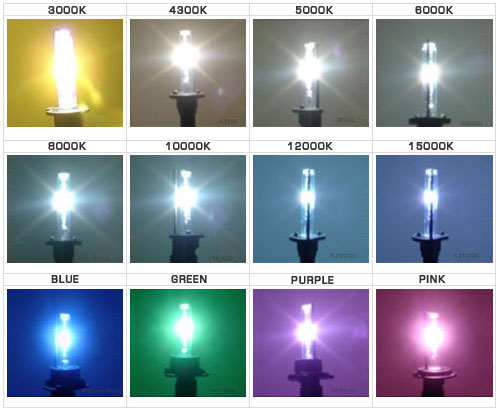
Xenon lamps and their color temperature
Content
Xenon car lamps are an excellent solution to the problem of poor visibility at night and in difficult weather conditions. Their use allows you to see objects at a considerable distance and improve driving safety. The eyes are less tired, which favorably affects the overall feeling of comfort behind the wheel.
Xenon lamps have several advantages over halogen lamps:
- They are 2-2,5 times brighter;
- Heat up much less
- They serve a set of times longer - about 3000 hours;
- Their efficiency is much higher - 90% or more.
Due to the very narrow emission frequency range, the light of a xenon lamp is almost not scattered by water droplets. This avoids the so-called light wall effect in fog or rain.
There is no filament in such lamps, so vibration during movement will not damage them in any way. The disadvantages include high cost and loss of brightness towards the end of its life.
Design features
The xenon lamp belongs to the category of gas discharge lamps. The design is a flask filled with xenon gas under considerable pressure.
The light source is an electric arc that occurs when voltage is applied to the two main electrodes. There is also a third electrode to which a high-voltage pulse is applied to strike the arc. This impulse is generated by a special ignition unit.
In bi-xenon lamps, it is possible to change the focal length to switch from low beam to high beam.
The main parameters
In addition to design features, the most important characteristics of the lamp are the supply voltage, luminous flux and color temperature.
Luminous flux is measured in lumens (lm) and characterizes the degree of illumination that a lamp gives. This parameter is directly related to power. Simply put, it's about brightness.
Many are confused by the concept of color temperature, which is measured in degrees Kelvin (K). Some believe that the higher it is, the brighter the light. This is an erroneous opinion. In fact, this parameter determines the spectral composition of the emitted light, in other words, its color. From this, in turn, depends the subjective perception of the illuminated objects.
Low color temperatures (less than 4000 K) tend to have a yellow tint, while higher color temperatures add more blue. The color temperature of daylight is 5500 K.
What color temperature do you prefer?
Most automotive xenon lamps that can be found on sale have a color temperature ranging from 4000 K to 6000 K, although other denominations occasionally come across.
- By 3200 - yellow color, characteristic of most halogen lamps. Most effective in fog lights. Tolerably illuminates the roadway in normal weather conditions. But for the main light, it is better to choose a higher color temperature.
- By 4300 - warm white color with a slight admixture of yellow. Especially effective during rain. Provides good visibility of the road at night. It is this xenon that is usually installed at manufacturers. Can be used for headlights and fog lights. The optimal balance in terms of safety and driving comfort. But not everyone likes its yellowness.
- By 5000 - white color, as close as possible to daylight. Lamps with this color temperature provide the best illumination of the roadway at night, but the set is inferior to xenon by 4300 K in adverse weather conditions.
If you prefer to spend rainy evenings at home, but do not mind driving on a night highway in dry weather, then this may be your option.
As the temperature rises above By 5000 Visibility is noticeably worse during rain or snow.
- By 6000 - bluish light. It looks spectacular, road lighting in the dark in dry weather is good, but for rain and fog this is not the best solution. However, some motorists claim that it is this xenon temperature that is good for a snowy track.
- By 6000 can be recommended to those who want to stand out and are concerned about tuning their car. If your safety and comfort is above all else, then move on.
- By 8000 - Blue colour. Does not provide sufficient illumination, therefore prohibited for normal use. Used for shows and exhibitions where beauty is required, not safety.
What else do you need to know for those who want to use xenon
If there is a need to change, you must first pay attention to the type of base.
You need to change both lamps at once, even if you only have one out of order. Otherwise, they will give uneven color and brightness light due to the aging effect.
If you want to put xenon instead of halogens, you will need adapted headlights. It is better to immediately purchase and install a complete set.
The headlights must have an automatic adjustment of the angle of installation, which will avoid blinding drivers of oncoming vehicles.
Washers are a must, as dirt on the headlight glass scatters light, degrades illumination and creates problems for other drivers.
Due to incorrect installation, the light may be too dim or, conversely, blinding. Therefore, it is better to entrust the work to professionals.
